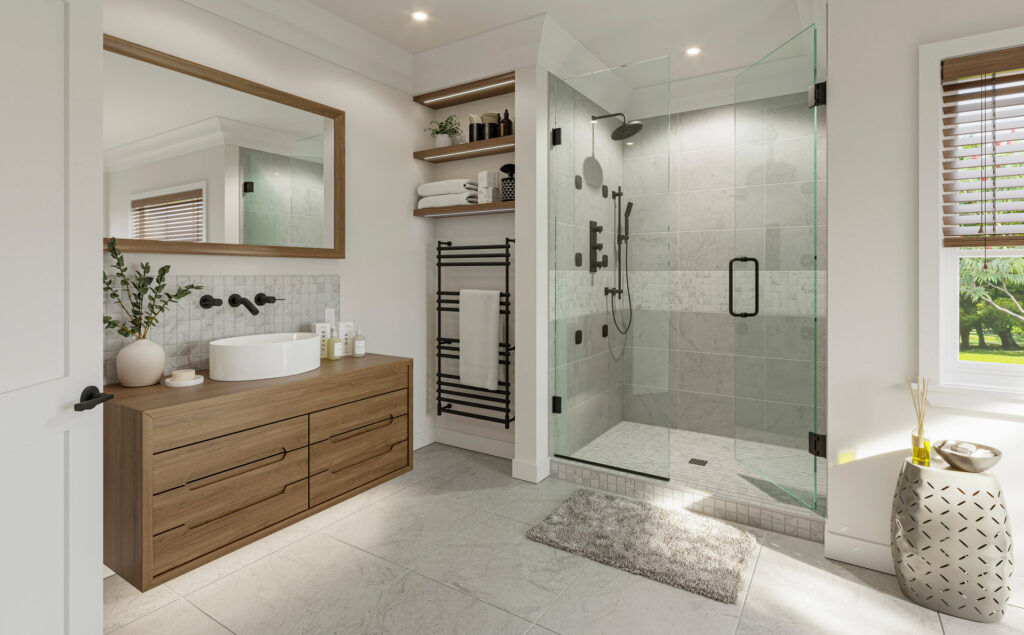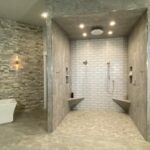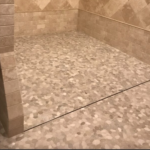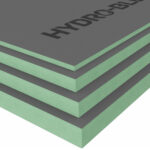When you’re planning a bathroom renovation or a new home build, one key decision is choosing between a modular vs traditional shower. These two systems offer very different experiences in terms of how they’re installed, how much they cost, and how well they perform over time.
Modular showers are becoming more popular thanks to faster installs, stronger waterproofing, and less room for error. Traditional showers still have their place, especially in fully custom builds. But which one’s right for you? Let’s break it down.
Understanding the Basics
あ traditional shower is built entirely from scratch on-site. Contractors frame the walls, install cement backer board, apply waterproofing membranes, and lay down mortar beds before tiling, grouting, and sealing everything in place. It’s a step-by-step build that takes days—or even weeks—and often requires multiple trades.
あ modular shower arrives with prefabricated waterproof panels and pre-sloped pans that lock together like a kit. Systems like HYDRO-BLOK come with everything you need—wall boards, curbs, pans, and more—all designed to work seamlessly together. With fewer steps and fewer tools, the install becomes much faster and simpler.
Installation Time and Complexity
Traditional shower builds take time. Every layer needs to be applied and cured before the next begins. Tile layout has to be done with precision, and grouting and sealing follow after. Any delay in these steps—or a misstep—can stall the entire project.
Modular showers remove most of this stress. Waterproof panels and pans arrive ready to install. With minimal cuts and strong sealants, the system can be installed by a single person, often in just one day. No waiting for layers to dry. No coordinating multiple trades. Just fast, reliable progress.
Waterproofing and Leak Protection
Waterproofing is where many traditional showers fall short. They rely on membranes, fabric sheets, and corner sealing done by hand. It works—but only if every step is flawless. One missed seam or tiny hole can cause water to seep into walls and floors.
Modular systems, on the other hand, build waterproofing right into the structure. HYDRO-BLOK panels have a foam core that resists water, sealed with cement coating and high-strength adhesives. No membranes to install. No missed corners. Just built-in protection you can trust.
Cost and Long-Term Value
Traditional materials like cement board and tile may seem cheaper. But when you factor in the cost of labor, time, and possible repairs, the total cost rises fast. Hiring tile pros and waterproofing specialists adds up quickly.
Modular systems might have a higher product price upfront, but they save money in labor and materials. They’re faster to install, which means fewer contractor hours. Plus, with fewer chances of leaking or failure, they hold their value better over time—making them a smart long-term choice.
設計の柔軟性
Traditional showers are completely customizable. You can frame any shape or size and tile it however you want. This freedom is why many designers still lean toward the traditional route, especially in luxury builds.
But modular systems aren’t far behind. Brands like HYDRO-BLOK offer panels and pans in various sizes and shapes, including options for benches, niches, and even curved layouts. You can trim panels to fit odd angles or replicate consistent designs across multiple bathrooms in a commercial property.
Unless you’re working with a truly unique bathroom footprint, modular systems now offer flexibility that fits most modern needs—with less mess and hassle.
Durability and Long-Term Performance
Durability in traditional showers depends on precise work. If everything’s done right, it can last for years. But one skipped step, poor sealing, or material breakdown can cause big problems later. Water damage behind tile isn’t just expensive—it’s hidden and hard to fix.
Modular systems remove many of those risks. The materials are engineered for moisture resistance, and the panels lock into place with proven adhesives. HYDRO-BLOK, for example, uses XPS foam that won’t rot, swell, or absorb water—perfect for high-use bathrooms or homes with kids and pets.
Ease of Maintenance
Traditional showers are harder to maintain. Grout lines can crack, tiles can shift, and any hidden leaks can go unnoticed until damage is done. Repairs often mean tearing out sections and starting over.
Modular systems make maintenance easier. Fewer seams. No grout between panels. And if a section ever needs replacing, you don’t need to demo the whole wall. You can fix the problem faster—and cleaner.
When a Modular Shower Makes More Sense
Let’s quickly look at scenarios where modular showers shine:
- You’re on a tight timeline
- You want to reduce labor costs
- You’re building multiple bathrooms (like in hotels or rentals)
- You’re handling the install yourself (DIY)
- You need to avoid leaks at all costs
- You want low-maintenance performance
In these cases, a modular system is a no-brainer.
Final Verdict: Modular vs Traditional Shower
So what’s the final call?
Traditional showers still make sense for ultra-custom, luxury designs—if you have the time, budget, and skilled labor. But for speed, waterproofing, simplicity, and long-term durability, modular systems take the win.
In the debate between a modular vs traditional shower, today’s best choice for builders, DIYers, and busy homeowners is clear: Go modular.
Ready to Make the Switch?
HYDRO-BLOK’s modular shower system offers a fully waterproof, tile-ready solution that’s easy to install and built to last.
Explore HYDRO-BLOK Shower Kits & Panels






この記事を共有する
プラットフォームを選択してください: